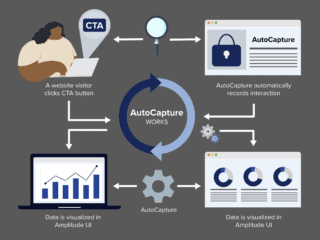At our recent Google Analytics 4 Ask Me Anything webinar Cardinal Path experts alongside Google responded to questions submitted by marketers, analysts, and developers about GA4. With hundreds of questions submitted, there seemed to be three distinct themes that emerged. This article addresses the three primary GA4 questions on the minds of marketers right now.
Register for our next Google Analytics 4 Ask Me Anything live panel webinar
What’s the difference between Universal Analytics and Google Analytics 4?
This question came in many forms:
It looks like GA4 is going to be easier/better, but right now it’s just one more new platform to learn – how is it different and how is it the same?
What are the main, most important advantages of GA4?
What are the benefits of GA4 for websites that do not have an app?
Our Answer:
Starting with the data model that underpins all aspects of data collection, processing, and reporting, Google Analytics 4 differs from Google Analytics Universal most notably in perhaps two ways:
Shift Away from Sessions
The concept of sessions, and of scope in general, is less prevalent in Google Analytics 4 than in Google Analytics Universal. While some session-related metrics and dimensions remain available in the reporting UI and the GA4 Data API, others such as Landing Page and Conversion Rate do not, at least currently, and sessions are not reflected at all in the BigQuery export schema for GA4.
In this way, GA4 takes a somewhat more agnostic approach to behavioral data collected from websites and mobile apps, allowing you to group a series of interactions in ways that are most meaningful to you.
Events and Parameters
The GA4 data model is based very directly on Google Analytics for Firebase (aka Firebase Analytics). All behavioral data is captured in GA4 in the form of events and as many as 25 parameters associated with the event. For those of us who are accustomed to Google Universal Analytics, this event paradigm in GA4 means that:
- a page_view is another type of event; there are no longer separate pageview and event hit types
- the three dimensions that we have used to describe events in GA Universal – Event Category, Event Action, and Event Label – have no direct equivalent in GA4. You can certainly still capture all the same descriptors of the interaction: for example, video, complete, corporate-video in Google Universal might instead be represented as event_name=video_complete with video_title=corporate-video as an event parameter. This is another reflection of the GA4 agnosticism and flexibility since the event parameters are inherently more meaningful and more aligned with the event that they’re describing.
This new data model has a ripple effect throughout the platform. Relative to Google Analytics Universal, the UI is different, the reports are different, the way things are organized is different, and the familiar core metrics are different. This is all rooted in the new GA4 data model.
This more agnostic, event-based model represents a seismic shift in the way that we understand and analyze the data and creates a more unified way of measuring the data that comes from both a website and an app.
Should I make the switch to Google Analytics 4?
This question came in many forms:
When do we expect Google to deprecate Universal Analytics?
Do you have to migrate to GA4?
How long until GA4 is required?
Our Answer:
It’s important to be very clear that Google has given us the heads-up about GA4 so that marketers, analysts, and developers can prepare for the inevitable transition to GA4. While the timeline for this transition has not been established, it will happen in the near future whether marketers want to make the change or not.
With that in mind, it’s also important to note that GA4 is still a work in progress, with updates and features rolling out regularly. Cardinal Path is currently not advising switching from Universal Analytics to Google Analytics 4 right now. Rather, we advocate that organizations implement dual tagging so you can explore GA4 and start to build historical data before switching is mandatory.
We liken this concept of having both UA and GA4 to that of a website. On your website, you likely have a staging site and your live production site. Your staging site is GA4. You can go in, play around with things, test things, and get comfortable with the changes you’re making. But at some point, you’re going to push staging to production.
A few of the new perks of GA4 include:
- More advanced insights and alerting based on Google’s advanced machine learning models
- Customer-centric measurement instead of measurement fragmented by devices/browsers/platforms.
- GA4 is designed to address long-term privacy and security concerns. It’s designed to adapt to a future with or without cookie identifiers
…and features that are reserved for the enterprise tier in Google Analytics Universal but are available in all Google Analytics 4 implementations:
- BigQuery export
- Advanced reporting templates, including updated, powerful Path Analysis
When will all the reports in Universal Analytics be available in Google Analytics 4?
Marketers are deeply concerned with feature parity across platforms and posed the most questions regarding this topic:
When will all of the old and loved reports from Universal Analytics make it into GA4 – if ever?
When will an enterprise/360 version of Google Analytics 4 be available?
How should we handle potential reporting gaps on core metrics like # of sessions?
What is the equivalent of ‘views’ in GA4?
Our Answer:
Keep in mind that Universal Analytics and Univeral Analytics 360 have been with us for many years and the product is packed with features. GA4 is in its early product evolution stages.
As of now, there isn’t feature parity in GA4 as in Universal Analytics. A lot of this has to do with the data model we mentioned above, but also that the product is still evolving. It’s recommended to take a dual-tagging approach ASAP.
For GA360 customers, you can still take advantage of GA360 features in Google Analytics Universal while collecting data in your GA4 property in parallel. When it does come time to transition fully to GA4, you’ll be in a better position as you’ll have more historical data than those who started dual-tagging later. Again, we’re not recommending a switch at this time; we’re recommending-dual tagging.
We’re recommending that you begin an earnest effort to inventory the data and reporting capabilities that you use in GA Universal and map to the data model and currently available reporting capabilities in GA4.
Conclusion
As we’ve mentioned, Google Analytics 4 is an evolving platform. Similarly, marketers and analysts will have new and evolving questions that arise. We are hosting a quarterly Google Analytics 4 Ask Me Anything live webinars along with regular blog posts to help keep you up to date and informed on how best to prepare your organization for this transition.
Author

Chief Technology Officer Feras Alhlou previously co-founded E-Nor in 2003 and served as President until its acquisition by Cardinal Path in 2019. Feras is passionate about his work with some of the world’s most recognized brands and public sector organizations to deliver data-driven marketing value. A recognized thought leader on the Google Marketing tech stack, he has traveled the globe educating businesses, practitioners, and consultants, and he’s also co-author of Google Analytics Breakthrough: From Zero to Business Impact. Feras received a Masters of Engineering Management degree from the University of South Florida and a Bachelor of Science degree in Electrical Engineering from the University of Tulsa. He is a Certified Web Analyst, Board Member for Red Cross Northern California, and a 3rd-degree black belt in Aikido.
View all posts



















